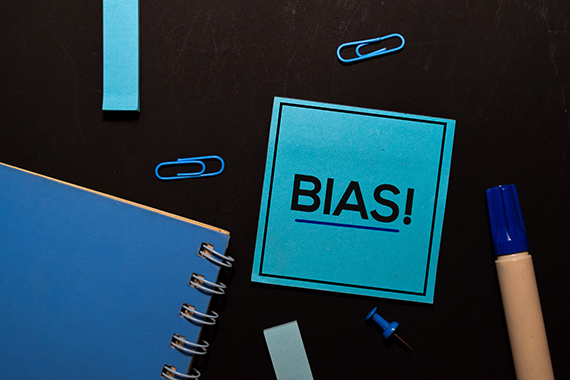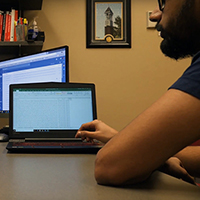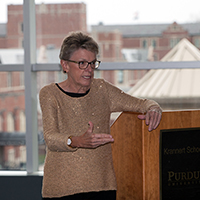
The Power of Undergraduate Research
Learning about implicit gender bias
As a sophomore in the Honors College at Purdue, I was looking for some experience doing research. To graduate with an honors degree, you must first complete a scholarly project or research. An advisor sent me in the direction of Denise Driscoll, a former lecturer in managerial communication at the Krannert School who was researching implicit bias. Fast forward and we are now wrapping up one implicit bias research project and starting another!
Through this process, I have learned a lot. First, I have a much better understanding of implicit bias, which is a thought or feeling that an individual associates with a group and is unaware of having. It can, however, influence the behaviors he or she consistently directs toward that group or its members in subtle ways that are often apparent only to the person experiencing the bias.
One of the most common biases I notice is assumptions made about the gender of a person based on their career. For example, I’ll be having a conversation about nurses with someone and start using the pronoun “she” to refer to the nurse without being told their gender. The nurse could have been male, but I am programmed to associate certain genders with certain careers.
Second, I have learned about some common biases people have about groups, such as beliefs about women being better at clerical and administrative types of tasks such as notetaking. This has made me be more aware of gender biases while working on teams and how they might influence others on the team.
Third, I can now recognize when implicit bias is happening, and I am improving every day at recognizing it in myself. I am also more aware of situations where my biases may appear. For example, it is known from research that when you meet new people, you are more at risk of implicit bias until you know more about them. I have seen this play out on a college campus. There is a common stereotype that has to do with men who belong to fraternities disrespecting women and partying a lot. But I have friends who are in fraternities who aren’t like that, and so I am careful when meeting new people to check my assumptions about them.
As part of doing research, I have learned about methods to help reduce implicit bias. We are currently working on a training tool to help students working on semester-long teams detect bias, reduce bias and prevent the negative effects it can have on a team. I have gone from knowing nothing about implicit bias to knowing enough to help others learn about it. I have learned that implicit bias is complicated. Even with all the training and exposure I’ve had to it, I still miss seeing it. One of my fellow research assistants would often come up to me and apologize for something he had said or done to me earlier in the week that he felt was due to implicit bias. Many times, I didn’t realize he had done anything. This is to say that implicit bias is an ongoing learning process.
Also, I knew very little about the research process, and now I am starting to think more critically about our method and what we learned from the subjects, as well as coding and data analytic techniques we will use to figure out what happened in the study. One of my biggest takeaways from this process is critical thinking. As we develop the methodology, we are constantly asking, “What is the purpose of asking this question? What information do we hope to gain from it?” The same goes for coding. For example, developing a coding method that extracts the information you need without a lot of irrelevant details is complicated. On top of that, you have to be thinking “How am I going to use this information in a research paper?” There is a lot of systems-level thinking involved with the process.
Being part of a research team has opened me up to other new experiences. Because of my involvement in the research from the very beginning, I was asked to speak at Purdue’s first International Women’s Conference in Chicago. It was an impactful and inspiring event. I left feeling empowered and ready to take on the world to make a change, as I’m sure many other women did, too.
I had never been to a conference before, let alone as a speaker. I was awestruck by everything, from my fancy little name ribbon to the powerful women who were seated around me. I almost felt like it I didn’t belong. There were many women there who had had more experience than me, so what made me qualified to talk to them about implicit gender bias? Add to that, I am an undergraduate student who has never been in the workforce full-time; nor do I have a family or any children yet.
These things make my life experiences different from theirs. It’s not that I don’t have a lot of responsibility. I pay for my own schooling as a full-time student, and I work about 15 hours a week. But I’m in a different place in my life than these older, professional women. And yet I found I could still relate to them about implicit gender bias. It is something that all women have experienced in life whether they realize it or not.
As the workshop with Dr. Driscoll started, I quickly realized that my age and lack of life experience did not disqualify me from sharing my story. While it was sad to hear how implicit gender bias had affected the lives of some of these women, it was amazing to see everyone come together over a shared experience. Hearing their stories empowered me even more to work on this research. While I always thought it was important, I now had all these powerful stories to back it up!
When I first started to do research, I was most excited about the training tool we were developing and the potential impact it could have on the work environment. As we move on to our new project, I am even more excited to see the changes that our training could make. The new project we are now working on is a method to help teams of students detect — and more flexibly respond to — instances of implicit bias that can interfere with the team’s working effectively together.
We hope soon to move the research into the applied setting of a classroom where we can get teams of students to be more aware of when their biases may trouble other team members. Our method also should help team members who may not be the target of implicit bias to recognize when it is happening and to take actions to mitigate its negative effect. This tool could change people’s lives! It has the potential to influence decisions made in teams on a daily basis, and I think that’s powerful.
I will forever be grateful for the opportunity to do research. I have learned and grown from it. It has truly helped me with my real-world problem-solving skills, I has also made me a more aware and inclusive person, thus making me a better leader. It’s been an invaluable experience that has profoundly shaped my college experience.








